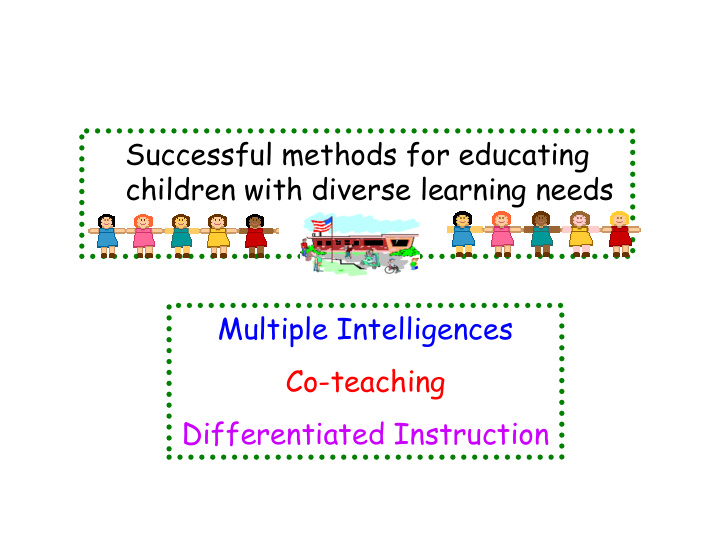



Successful methods for educating children with diverse learning needs Multiple Intelligences Co-teaching Differentiated Instruction
Howard Gardner Theory of Multiple Intelligences • Categories • Theory • Language-related – Gardner • Verbal/linguistic hypothesed that • Musical/rhythmic every individual • Personal-related possesses several different and • Interpersonal independent • Intrapersonal capacities for • Object-related solving problems • Bodily/kinesthetic and creating • Visual/spatial products. • Logical/mathematical • Naturalist
Elements of the MI Classroom 1. Trust and Belonging – child feels he/she belongs, can contribute, is considered important by the teacher and peers, and is challenged by high, consistent expectations. 2. Meaningful Content – multiple intelligences aligned to district outcomes 3. Adequate time
Elements of the MI Classroom 1. Enriched environment • Focused unit of study • Students’ work displayed • Places for independent work such as learning centers • Places for collaborative learning • Hands –on environment with manipulatives • Central place for total class gatherings 2. Intelligent choices – teacher outlines parameters and opportunities for choice
What is Co-teaching A special education service delivery model whereby two certified teachers, one general educator and one special educator, share responsibility for planning, delivering, and evaluating instruction for a diverse body of students, some of whom have disabilities. The RISE Project Dr. Tom Buggy, Director
Critical Elements • Coordinated efforts of teachers to achieve at least one common, mutually agreed upon goal. • Shared belief system that each member has unique and needed expertise. • Parity as giver and receiver of knowledge and skills. The RISE Project Dr. Tom Buggy, Director
Critical Elements • Use of “distributed functions” theory of leadership for task and leadership functions usually found in lone teacher role. • Use of cooperative process that includes face to face interactions, positive interdependence, performance, interpersonal skills, and individual accountability. The RISE Project Dr. Tom Buggy, Director
Co-teaching Strategies Duet Model – both teachers equally involved Lead and Support Model – one teacher is responsible for planning a unit of instruction and the other delivers the instruction and monitors the classroom Speak and Add/Chart Model - one teacher designs and delivers instruction and the other expands with questions, info on charts, transparencies, etc.
Co-teaching Strategies Skills Group Model – students are divided into 2-4 groups based on instructional need and 1 teacher is responsible for ½ of the groups Station Teaching Model – one teacher is responsible for overall instruction and one teaches specific skills to a small group
Co-teaching Strategies Learning Style Model – both teachers share in the design and delivery of instruction. One teacher is responsible for the auditory and visual instruction and the other for tactile and kinesthetic instruction Parallel Model – both teachers plan and design instruction. The class is split into two groups and each teacher takes one group
Co-teaching Strategies Complementary Instruction Model – one teacher delivers core content and the other delivers related instruction in the areas of study and survival skills Adapting Model – one teacher plans and delivers a unit of instruction and the other determines and provides adaptations in the moment for students who are struggling
In a differentiated classroom, the teacher proactively plans and carries out varied approaches to content, process, and product in anticipation of and response to student differences in readiness, interest, and learning needs.
Differentiated instruction is: Proactive More Qualitative than Quantitative Multiple Approaches to Content Student Centered A Blend of Whole-Class, Group, and Individual Instruction Dynamic
1. Content Readiness differentiation of content has as its goal matching the material or information to a student’s capacity to read and understand it. Interest differentiation of content involves including in the curriculum ideas and materials that build on or extend current student interests. Learning profile differentiation of content ensures that a student has a way of ‘coming at’ materials and ideas that match his preferred way of learning.
2. Process (Sense-making activity) Readiness differentiation of process means matching the complexity of a task to a student’s current level of understanding and skill. Interest differentiation of process involves giving students choices about facets of a topic in which to specialize or helping them link a personal interest to a sense-making goal. Learning profile differentiation of process means encouraging students to make sense of an idea in a preferred way of learning.
3. Product helps the student rethink, use and extend what they have learned over a long period of time. serves as assessment tools. helps students apply ideas and skills. Teachers determine core expectations for quality, determine how they can help the student, and model the expectation. The assignment clarifies what knowledge, understanding, and skills must be included. Adaptations can be made to the core product according to student readiness, interest, and learning profile.
School-wide Factors Influencing Co-teaching and Differentiated Instruction (DI) Administrative Supports for Co-teaching and/or DI as an Approach Special Education Caseloads Voluntary vs Involuntary Participation Scheduling (for teaching and planning) Interpersonal Skills /Problem Solving Techniques Coaching Capacities The RISE Project Dr. Tom Buggy, Director
Recommend
More recommend